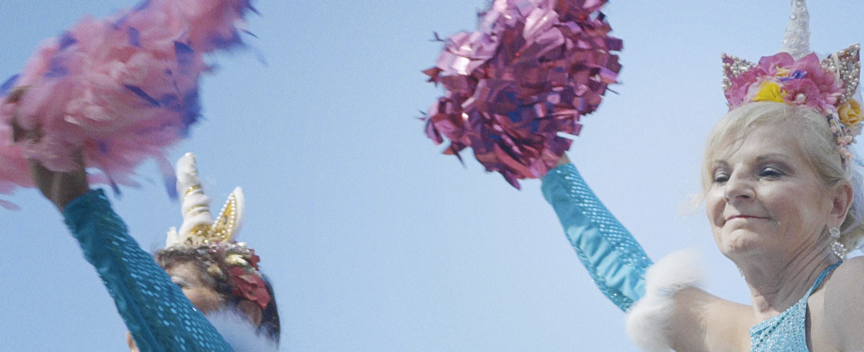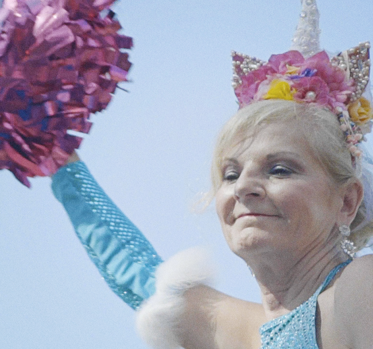
The Language of Dance in Documentary Filmmaking
Interview by Maria Malmström
“You can have an interview with someone and chat for hours and then you watch them dance and that’s when you truly get up close and personal”
Calendar Girls creators and feature documentary debut directors Maria Loohufvud and Love Martinsen met with choreographer Maria Malmström to discuss the intersection of documentary filmmaking and dance.
We’re used to seeing dance in musicals and dance films. Do you take a different approach when using dance in documentary storytelling?
In a way, we opted for a stylised, polished, musical number feel for the choreographed scenes in the film and a more documentary approach for the portraits. We wanted to tell the story of the characters in the most authentic way, which for us meant to have their processes and zest for life in mind for the choreographed sequences as well as letting the personal portraits feel honest and genuine.
Since we created the choreographed dance scenes from interviews with the women and the overall concept of the film, we wanted to present concepts like the concept of the pressure of beauty in ageing as well as letting the dance be an empowering expression. We wanted it to be complex and open at the same time and give room for the audience’s own experience when seeing the film. The dance pieces also create a moment of breath and reflection for the audience to take the story in.
Do you think the dance scenes are central to the storyline of the film?
In our case, yes, they’re essential in determining the character of the film. The dance scenes bring us closer to the women, without having to use too many words. We get to understand their feelings and emotions through their movement; it’s a powerful way of communicating. You can have an interview with someone and chat for hours and then you watch them dance and that’s when you truly get up close and personal.
What does the process look like when you create dance scenes?
There were certain highlights in the structure of the story we knew we wanted to amplify through specific framing and elements of choreography, some being more choreographed than others. For example, the car park scene we blocked out and rehearsed in Sweden with a friend of ours. We filmed the rehearsal and did a rough cut, so once we got to rehearse with the women we could modify from the base that we already had. It was also easy for us to have a quick turnaround since it’s just the two of us doing everything – directing, filming, editing, music and choreography. Reviewing and going back and changing as we went along helped a lot in creating the final version.
The dance portraits are more improvised. We had an idea in mind but stayed flexible around the when and how those dance scenes would take place. We wanted to capture the moment and shoot the sequences in real time, not having to go back two months later and re-create an emotion or feeling, avoiding that fabricated feel. We think you have to stay present. Some of the moments we captured we couldn’t have planned for and we wanted to let the film evolve as our relationship with the Calendar Girls grew.
The group was very willing to collaborate and give us time in between shows. They really couldn’t have given us more.
Tell us about the process around the music in the film.
All the music for the dance scenes, as well as the score, was written by Love. So the thought process in the music has been present from day one of filming. We knew we wanted the music to fit the different personalities, and that the music should be something the women themselves would like. When filming the dance scenes we worked with temporary music that fit the emotional landscape the characters were in, and that set the tempo for the dancers. From there we gave simple movement direction, symbolic for the emotions they were portraying. We started composing the final music at the same time as editing the dance scenes. It was a very dynamic process.
Do you consider the dance scenes to be documentary or fiction? Is that an important distinction for the film?
It’s not specifically important in this context. We think it’s obvious that the choreographed sequences are an outside interpretation of the women and the important aspect is that what they symbolise isn’t fictive. When you work close to someone like this you build a relationship and it was both our desire and our responsibility to portray their feelings in an honest way.
What was your focus when choreographing? Were there any challenges in creating the material?
It was very important to choreograph from the dancer’s ability and enhance what they were able to do, things that looked effective and visually appealing on camera. Talking to the choreographer of the group, we used similar approaches and learned from her way of choreographing using formations, synchronised sections and focusing on simple movements that looked effectfull.
The dancers all had a beautiful ability to move from their hearts and to be vulnerable and open with us. Their willingness to expose themselves in front of us and the camera made everything easier. We hope and think that comes from trust between the filmmaker and the subject. As filmmakers, we have to trust our intuition and lean into the process. Sometimes it turns out better than expected, and sometimes we end up not using it, and that’s all part of creating.
